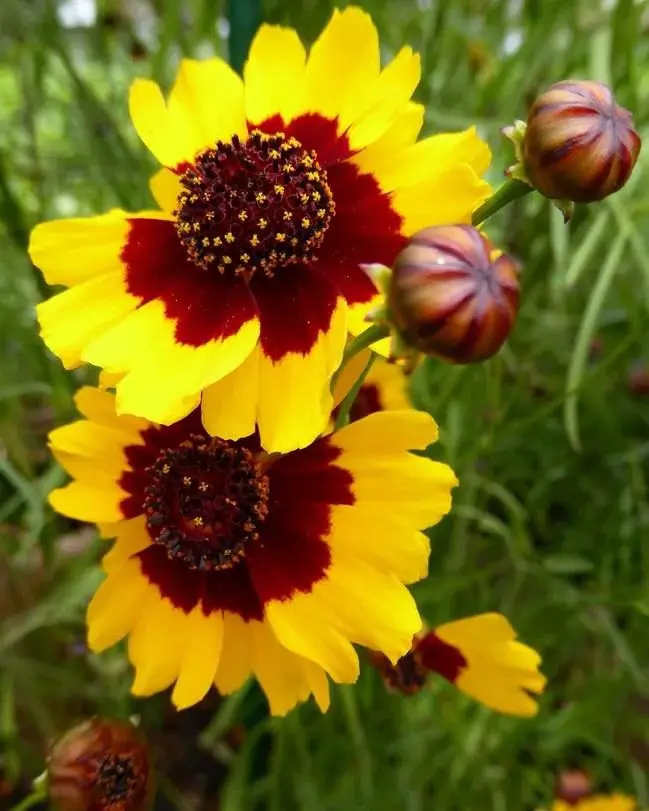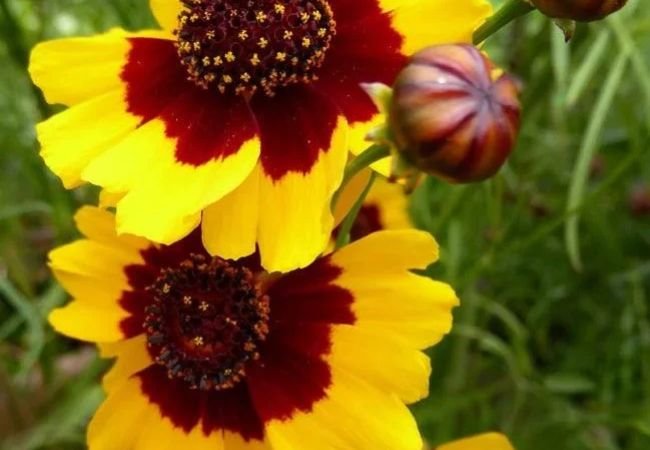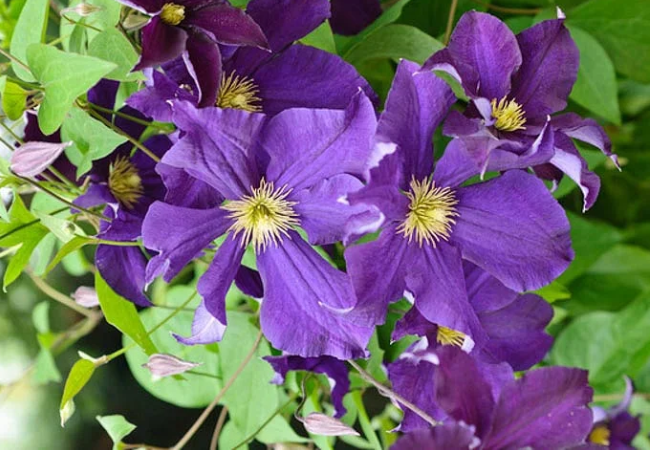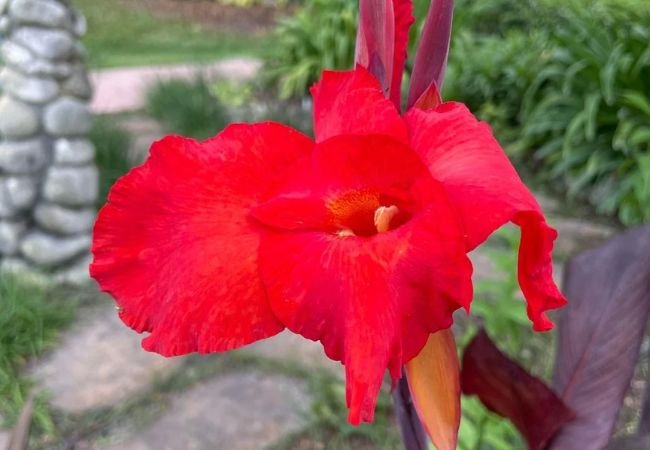Learn everything about the Coreopsis flower, from its meaning and benefits to how to grow and care for it. Perfect for beginners and seasoned gardeners alike.
Hello, fellow garden lovers! I’m Ashley Scott, and with 10 years of gardening experience, I’ve had the pleasure of growing many beautiful flowers. But one that holds a special place in my heart is the Coreopsis flower, also known as Tickseed. If you’re looking for a low-maintenance, drought-tolerant, and long-blooming flower to brighten up your garden, Coreopsis is a perfect choice. In this guide, I’ll share everything you need to know about this cheerful bloom, from its meaning and benefits to how to grow and care for it. Whether you’re a seasoned gardener or just starting out, this article will help you make the most of this vibrant flower.
What Is a Coreopsis Flower?

The Coreopsis flower, commonly known as Tickseed, is a native North American plant that belongs to the Asteraceae family. It’s famous for its daisy-like blooms that come in a variety of colors, including yellow, red, orange, pink, and even white. The name “Coreopsis” comes from the Greek words koris (bedbug) and opsis (resembling), referring to the shape of its seeds, which look like tiny ticks—hence the common name Tickseed. But don’t let that deter you; these flowers are anything but pesky! They’re easy to grow, attract pollinators, and bloom from early summer until the first frost.
Fun Fact: Coreopsis is the state wildflower of Florida and has been used by Native Americans to make natural dyes.
Coreopsis Flower Meaning and Symbolism
Flowers often carry deeper meanings, and Coreopsis is no exception. In the language of flowers, Coreopsis symbolizes “always cheerful.” Its bright, sunny blooms are a reminder to stay positive and embrace joy, even on cloudy days. I’ve always found that having Coreopsis in my garden lifts my spirits—it’s like a little burst of sunshine right outside my window.
Pro Tip: If you’re looking to add a touch of positivity to your garden or gift a meaningful bouquet, Coreopsis is a great choice.
Types of Coreopsis Flowers
There are over 80 varieties of Coreopsis, each with its own unique charm. Here are some popular types you might want to consider for your garden:
- Coreopsis grandiflora ‘Early Sunrise’: Known for its large, semi-double, bright yellow flowers that bloom early in the season.
- Coreopsis verticillata ‘Moonbeam’: Features buttery yellow flowers and a compact, dense shape, perfect for borders.
- Coreopsis rosea ‘Nana’: A dwarf variety with mauve-pink blooms that spreads beautifully but needs a bit more water.
- Coreopsis tinctoria (Plains Coreopsis): An annual variety with yellow-red flowers and dark-red centers, often found in wildflower seed mixes.
Each type offers something special, whether it’s the color, size, or blooming period. I’ve grown several varieties over the years, and they all bring something unique to the garden.
How to Grow Coreopsis Flowers
One of the best things about Coreopsis is how easy it is to grow. Whether you’re planting from seeds or transplants, here’s what you need to know:
When to Plant Coreopsis
- Perennial Coreopsis: Plant in spring or early fall.
- Annual Coreopsis: Sow seeds directly in the ground after the last spring frost or start indoors 6-8 weeks earlier.
Where Does Coreopsis Grow Best?
Coreopsis thrives in full sun, needing at least 6-8 hours of direct light daily. While it can tolerate partial sun, you’ll get the best blooms in a sunny spot. It’s also adaptable to various soil types, as long as the soil is well-draining. Avoid heavy, wet clay soils, as they can cause root rot.
Personal Tip: In my garden, I’ve found that Coreopsis does exceptionally well in slightly sandy soil. If your soil is heavy, mix in some compost to improve drainage.
How to Plant Coreopsis Seeds
- Direct Sowing: Scatter seeds on the soil surface after the last frost. Don’t cover them, as they need light to germinate.
- Indoor Sowing: Use a potting mix with peat moss or perlite. Keep the soil warm (around 70°F) and moist until germination.
Pro Tip: If you’re starting seeds indoors, place them near a sunny window or under grow lights to ensure they get enough light.
Caring for Coreopsis Flowers
Once established, Coreopsis is a low-maintenance plant that doesn’t demand much attention. Here’s how to keep it thriving:
Watering
- New Plants: Water regularly until they’re established.
- Established Plants: Coreopsis is drought-tolerant and only needs water during prolonged dry spells.
My Experience: I’ve noticed that overwatering can lead to fewer blooms, so it’s best to let the soil dry out between waterings.
Fertilizing
Coreopsis doesn’t need much fertilizer. In fact, too much can lead to excessive foliage growth and fewer flowers. If your soil is poor, mix in a little compost in early spring.
Pruning and Deadheading
To encourage continuous blooming, deadhead spent flowers regularly. You can also cut back the plant by about one-third in mid-summer to promote a second flush of blooms.
Pro Tip: Deadheading is easy—just pinch off the faded flowers with your fingers or use small pruning shears. It’s a relaxing way to spend a few minutes in the garden!
Coreopsis Flower Benefits
Beyond its beauty, Coreopsis offers several benefits for your garden and the environment:
- Attracts Pollinators: Bees, butterflies, and hoverflies love Coreopsis flowers for their nectar and pollen.
- Deer-Resistant: If you have deer in your area, you’ll be happy to know that Coreopsis is rarely bothered by them.
- Long Blooming Period: With proper care, Coreopsis can bloom from early summer until the first frost.
- Low Maintenance: Once established, it’s drought-tolerant and requires minimal care.
Fun Fact: Birds and other wildlife enjoy snacking on Coreopsis seeds in the fall and winter, making it a great addition to a wildlife-friendly garden.
Coreopsis Flower Colors and Varieties
Coreopsis flowers come in a range of stunning colors, including:
- Yellow Coreopsis Flower: The most common and classic color, perfect for adding a sunny vibe to your garden.
- Red Coreopsis Flower: Varieties like ‘Razzle Dazzle’ offer striking red petals with white tips.
- Orange Coreopsis Flower: Bright and bold, orange Coreopsis adds a pop of color to any landscape.
- White Coreopsis Flower: Varieties like ‘Snowberry’ feature creamy white blooms with burgundy centers.
- Pink Coreopsis Flower: Soft pink blooms add a touch of elegance to borders and containers.
My Favorite: I’m particularly fond of the yellow Coreopsis flower for its ability to brighten up even the dullest corners of my garden.
Is Coreopsis a Summer or Winter Flower?
Coreopsis is primarily a summer flower, blooming from early summer until the first frost. However, in warmer climates, some varieties can continue to bloom into the fall. It’s not a winter flower, as it goes dormant in colder months.
Pro Tip: To extend the blooming season, deadhead regularly and provide a light layer of mulch in the fall to protect the roots.
Coreopsis Flower Images and What They Look Like
If you’re wondering, “What does a Coreopsis flower look like?” imagine a daisy-like bloom with a central disk surrounded by ray-like petals. The flowers can be single or double, and the foliage varies from large green leaves to narrower, thread-like greenery.
Visual Tip: Check out these Coreopsis flower images for inspiration on how to incorporate them into your garden.
Are Coreopsis Flowers Edible?
While Coreopsis flowers are not commonly eaten, they are technically edible. However, they’re not known for their flavor, and some people may find them slightly bitter. I wouldn’t recommend them for your next salad, but they can be used as a decorative garnish in small amounts.
Safety Note: Always ensure that any flower you consume is free from pesticides and safe for human consumption.
Coreopsis vs. Blanket Flower
You might be wondering how Coreopsis compares to another popular flower, the Blanket Flower (Gaillardia). While both are drought-tolerant and attract pollinators, there are key differences:
- Coreopsis: Typically has yellow, orange, or pink flowers with a more delicate appearance.
- Blanket Flower: Features bold red and yellow blooms with a more rugged look.
Both are excellent choices for sunny gardens, but Coreopsis tends to have a longer blooming period.
Common Questions About Coreopsis Flowers
Here are some frequently asked questions about Coreopsis, answered for your convenience:
1. How do I propagate Coreopsis?
You can propagate Coreopsis by division in spring or early fall. Simply dig up a mature plant, split it into smaller sections with healthy roots, and replant.
2. Can Coreopsis grow in containers?
Yes! Coreopsis does well in containers as long as they have good drainage. Choose a compact variety like ‘Nana’ for best results.
3. How long do Coreopsis flowers last in a vase?
Coreopsis flowers can last 7-10 days in a vase, making them a great choice for cut flower arrangements.
4. What pests or diseases affect Coreopsis?
Coreopsis is generally pest-resistant but can occasionally be affected by aphids, slugs, or fungal diseases like powdery mildew.
Coreopsis Flower Seeds: How to Collect and Sow
If you want to grow Coreopsis from seeds, you can either buy them or collect them from existing plants. Here’s how:
- Collecting Seeds: Wait until the flowers fade and the seed heads dry out. Shake the seeds into a paper bag and store them in a cool, dry place.
- Sowing Seeds: Follow the planting instructions above for direct sowing or indoor starting.
Pro Tip: Coreopsis seeds need light to germinate, so don’t cover them with soil. Just press them lightly into the surface.
Coreopsis Flower Benefits for Your Garden
In addition to its beauty, Coreopsis offers several practical benefits:
- Soil Erosion Control: Its spreading habit makes it great for stabilizing soil on slopes.
- Natural Dye: The flowers can be used to create yellow, orange, and red dyes.
- Medicinal Uses: Some Native American tribes used Coreopsis in teas for its potential health benefits, though this is not widely practiced today.
My Experience: I’ve used Coreopsis as a natural border plant to prevent soil erosion in my garden, and it works wonders!
Conclusion
The Coreopsis flower, or Tickseed, is a must-have for any garden enthusiast. Its cheerful blooms, low-maintenance care, and ability to attract pollinators make it a standout choice. Whether you’re planting it for its beauty, symbolism, or environmental benefits, Coreopsis is sure to bring joy to your outdoor space. So, why not add a splash of sunshine to your garden this season?
For more gardening tips and inspiration, check out these related articles on USA Garden Hub:
- How to Create a Pollinator-Friendly Garden
- Vibrant Flowers in Miami, FL : A Guide to Tropical Blooms
Happy gardening!






